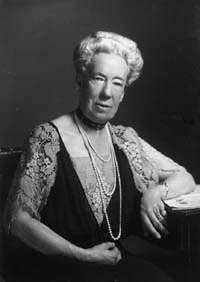Elizabeth Cadbury
Dame Elizabeth Mary Cadbury DBE (24 June 1858 – 4 December 1951; née Taylor) was a British philanthropist and wife of George Cadbury, the chocolate manufacturer.
Elizabeth Cadbury DBE | |
|---|---|
 Dame Elizabeth Cadbury | |
| Born | Elizabeth Mary Taylor 24 June 1858 Peckham Rye, London, England |
| Died | 4 December 1951 (aged 93) |
| Spouse(s) | |
| Children | 6, including: Egbert Cadbury Marion Greeves |
| Parent(s) | John Taylor Mary Jane Cash |
Early life
Born in Peckham Rye, London, she was one of ten children of the Quaker company director and stockbroker John Taylor (d. 1894) and his wife, Mary Jane Cash (d. 1887). She grew up in an affluent family background. Her parents were active temperance crusaders, and enthusiasts for the adult education provided by mechanics' institutes.
She and her sister Margaret were educated privately in Germany, and Elizabeth then attended North London Collegiate School from 1874–76. In 1876 she passed the senior Cambridge University examination in ten subjects, but did not enter higher education. On leaving school she did social work in the London docks and Paris, as well as teaching at the Sunday school of her Quaker meeting.[1]
Family life
In 1888 she married George Cadbury, then a widower with five children. They had six children together as well: Laurence John, George Norman, Elsie Dorothea, Egbert, Marion Janet, and Ursula.
Activism
She and her husband played a great role in the development of Bournville and opened the 200th house there herself. In 1909 she opened the Woodland Hospital, which became the Royal Orthopaedic Hospital. She also built The Beeches, to provide holidays for slum children. She chaired the Birmingham school medical service committee and worked energetically to provide medical inspection in schools. From 1941 to 1948 she was president of the United Hospital in Birmingham. Throughout her life she campaigned for the education and welfare of women as a convinced but non-militant suffragist.[2]
The founder in 1898 of the Birmingham Union of Girls' Clubs, she was active in the YWCA and in the National Council for Women from 1896 to her death. She was Vice President of the Electrical Association for Women, an organisation which sought to promote the benefits of electricity in the home and alleviate women's domestic drudgery.[3] In 1936, at the age of seventy-eight, she led the UK delegation to the World Congress of the International Council of Women, held in Calcutta.
An active pacifist she was the first chair of the Peace and International Relations Committee of the National Council of Women, established in 1914. In 1916 she was elected to the National Peace Council, becoming its treasurer and then its vice-president. Along with Lady Aberdeen, Millicent Fawcett, and Mrs Corbett Ashby, she pressed for the inclusion of women's issues in the agenda of the Congress of Versailles. She was an energetic supporter of the League of Nations Union. During the Second World War, she worked with Belgian refugees, and after that war continued her efforts with the International Council of Women.[4]
In national politics Elizabeth Cadbury's sympathies were similar to those usually associated with Christian socialism, and she was a pillar of the Liberal Party. She was a Birmingham city councillor, for King's Norton ward, from 1919 to 1924, as a Liberal, losing her seat to a Conservative. Her political platform was a reformist one: municipal action in housing improvement, a school health service, and equality of opportunity. Among her political successes were her co-option to the Birmingham education committee in 1919, and her services as a magistrate from 1926. Cadbury also fought the King's Norton seat for the Liberals at the 1923 general election coming third but maintaining the Liberal share of the vote at 25%.[5]
Manor Farm
The family home was Woodbrooke in Selly Oak, Birmingham, until 1894, when they moved to Manor Farm, now the Manor House, Bristol Road, Northfield, Birmingham. They lived there together until George's death in 1922, and Elizabeth Cadbury resided there until her own death in 1951, aged 93. During the World War II, she invited the Friends' Ambulance Unit to establish its training centre in the grounds. The grounds were also sometimes used for garden parties and other events in aid of worthy causes.
In 1948, at the family gathering to celebrate her ninetieth birthday, there were 150 relatives. At her death, Elizabeth Cadbury was survived by, among others, 37 grandchildren and 49 great-grandchildren.
Honours
- For her public service Elizabeth Cadbury was made an OBE in 1918 and a DBE in 1934.
- The Belgian government honoured her in 1918 for her work with refugees, making her an officer of the Order of the Crown (Belgium), and she was decorated by Queen Elisabeth of the Belgians.
- The Red Cross organizations of Serbia, Greece, and Yugoslavia also made awards to her for her war work.
- The University of Birmingham made her an honorary MA in 1919 for her services to education and to the city.
- The former Dame Elizabeth Cadbury Technology College, now Dame Elizabeth Cadbury School, in Birmingham is named in her honour. [7]
References
- Sara Delamont, Dame Elizabeth Mary Cadbury in Oxford Dictionary of National Biography online; OUP 2004-12
- Helen Smith, Uncovering the Life and Archive of Dame Elizabeth Taylor Cadbury, Quaker Philanthropist; Women's History Network Blog, 2010: http://womenshistorynetwork.org/blog/?tag=elizabeth-taylor-cadbury
- EAW (1950). EAW Silver Jubilee Handbook 1950. IET Library and Archives.
- Sara Delamont, Dame Elizabeth Mary Cadbury in Oxford Dictionary of National Biography online; OUP 2004-12
- F W S Craig, British Parliamentary Election Results 1918-1949; Political Reference Publications, Glasgow 1969 p86
- Who was Who; OUP online December 2007
- "Dame Elizabeth Cadbury School".
Sources
- Delamont, Sara. "Dame Elizabeth Cadbury". Retrieved 2009-06-03.
| Non-profit organization positions | ||
|---|---|---|
| Preceded by Mary Clifford |
President of the National Union of Women Workers 1905–1907 |
Succeeded by Mrs Edwin Gray |